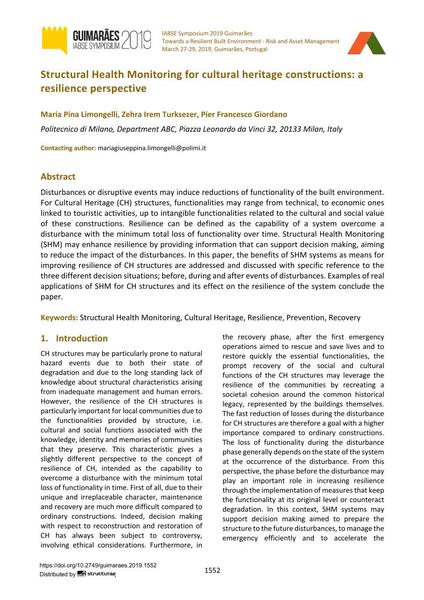Structural Health Monitoring for cultural heritage constructions: a resilience perspective

|
|
|||||||||||
Bibliographic Details
| Author(s): |
Maria Pina Limongelli
(Politecnico di Milano, Department ABC, Piazza Leonardo da Vinci 32, 20133 Milan, Italy)
Zehra Irem Turksezer (Politecnico di Milano, Department ABC, Piazza Leonardo da Vinci 32, 20133 Milan, Italy) Pier Francesco Giordano (Politecnico di Milano, Department ABC, Piazza Leonardo da Vinci 32, 20133 Milan, Italy) |
||||
|---|---|---|---|---|---|
| Medium: | conference paper | ||||
| Language(s): | English | ||||
| Conference: | IABSE Symposium: Towards a Resilient Built Environment Risk and Asset Management, Guimarães, Portugal, 27-29 March 2019 | ||||
| Published in: | IABSE Symposium Guimarães 2019 | ||||
|
|||||
| Page(s): | 1552-1559 | ||||
| Total no. of pages: | 8 | ||||
| DOI: | 10.2749/guimaraes.2019.1552 | ||||
| Abstract: |
Disturbances or disruptive events may induce reductions of functionality of the built environment. For Cultural Heritage (CH) structures, functionalities may range from technical, to economic ones linked to touristic activities, up to intangible functionalities related to the cultural and social value of these constructions. Resilience can be defined as the capability of a system overcome a disturbance with the minimum total loss of functionality over time. Structural Health Monitoring (SHM) may enhance resilience by providing information that can support decision making, aiming to reduce the impact of the disturbances. In this paper, the benefits of SHM systems as means for improving resilience of CH structures are addressed and discussed with specific reference to the three different decision situations; before, during and after events of disturbances. Examples of real applications of SHM for CH structures and its effect on the resilience of the system conclude the paper. |
||||
| Keywords: |
cultural heritage structural health monitoring resilience recovery Prevention
|
||||
